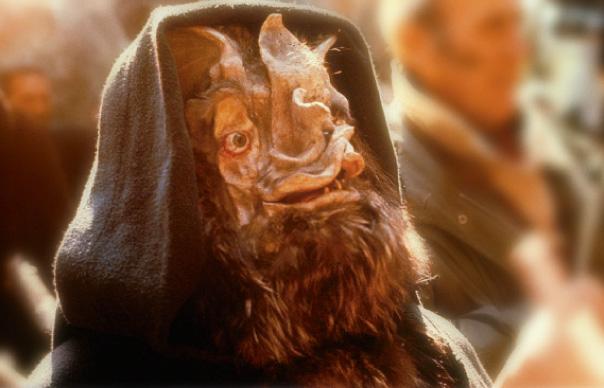Revitalising re-release for classic 70's horror... “Are you bent on reviving forgotten horrors?” You could apply that line to pretty much the entire British horror genre, so obsessed has it been with the unearthing of powers that have lurked, dormant, ready to wreak havoc once released from their burial site. And so it is at the very start of Piers Haggard’s Blood On Satan’s Claw, when a camera tracks the gouging of a 17th century ploughman’s blade through crumbly soil. Out of the earth emerges a grisly skull, with fur attached and a functioning eyeball. It promptly disappears, never to be found again, but its malefic influence begins to work in insidious ways upon the village. Mysterious fur patches appear on limbs; a claw bursts out of a wooden floor; fevers and hysteria spread through the population as it becomes clearer that the Devil is attempting to incarnate himself on earth. Released in 1971, Blood On Satan’s Claw is the second of the three movies which almost entirely constitute the mini-genre now known as ‘folk horror’. Sandwiched between Michael Reeves’s Witchfinder General (1968) and The Wicker Man (1973), the film shares the central theme of Christian forces struggling to suppress a mushrooming pagan revival. The Satanic influence – which, unlike in Witchfinder General, takes a grotesquely visceral form here – mostly afflicts the younger villagers, who retreat to the woodland deeps to conduct what are repeatedly described as “their games” – sexual violence and sacrifice. The confrontation between local priest, the appropriately named Reverend Fallowfield (Anthony Ainley) and cult leader Angel Blake (Linda Hayden), in which she tries to seduce him in his chapel, is one of the most erotic sequences British horror has ever produced, one which enacts the potency of Britain’s latent paganism in graphic terms. A scene in which a teenage girl is raped, while the whole cult, plus two demented old folk, look on, even feels over the top 40 years later – so brutal that Haggard himself has declared he’d have shot it differently today. Cinematographer Dick Bush shot the rural landscape in a gorgeous swatch of leafy greens, terracotta and overcast skies. The locals’ deep connections with the land are integral to the film’s design: Bush frequently mounts the camera at ground level, literally rubbing your face in the mud. Odeon’s Blu-Ray transfer has really lifted the film, making it look far more ‘expensive’ than it has done previously, benefiting both the superb Oxfordshire locations as well as some magnificent natural light effects, such as the weird sunlit glow around Angel at the peak of her seductive powers. The frame often flickers with fires and candlelight, and the period detail has a muted simplicity that feels more convincing than, say, one of Hammer’s cookie-cutter sets. In this enhanced version, it has clawed its way to a new status as one of the great British movies of the era. EXTRAS: Commentaries, Making Of, documentaries. 8/10 Rob Young
Revitalising re-release for classic 70’s horror…
“Are you bent on reviving forgotten horrors?” You could apply that line to pretty much the entire British horror genre, so obsessed has it been with the unearthing of powers that have lurked, dormant, ready to wreak havoc once released from their burial site. And so it is at the very start of Piers Haggard’s Blood On Satan’s Claw, when a camera tracks the gouging of a 17th century ploughman’s blade through crumbly soil. Out of the earth emerges a grisly skull, with fur attached and a functioning eyeball. It promptly disappears, never to be found again, but its malefic influence begins to work in insidious ways upon the village. Mysterious fur patches appear on limbs; a claw bursts out of a wooden floor; fevers and hysteria spread through the population as it becomes clearer that the Devil is attempting to incarnate himself on earth.
Released in 1971, Blood On Satan’s Claw is the second of the three movies which almost entirely constitute the mini-genre now known as ‘folk horror’. Sandwiched between Michael Reeves’s Witchfinder General (1968) and The Wicker Man (1973), the film shares the central theme of Christian forces struggling to suppress a mushrooming pagan revival. The Satanic influence – which, unlike in Witchfinder General, takes a grotesquely visceral form here – mostly afflicts the younger villagers, who retreat to the woodland deeps to conduct what are repeatedly described as “their games” – sexual violence and sacrifice. The confrontation between local priest, the appropriately named Reverend Fallowfield (Anthony Ainley) and cult leader Angel Blake (Linda Hayden), in which she tries to seduce him in his chapel, is one of the most erotic sequences British horror has ever produced, one which enacts the potency of Britain’s latent paganism in graphic terms. A scene in which a teenage girl is raped, while the whole cult, plus two demented old folk, look on, even feels over the top 40 years later – so brutal that Haggard himself has declared he’d have shot it differently today.
Cinematographer Dick Bush shot the rural landscape in a gorgeous swatch of leafy greens, terracotta and overcast skies. The locals’ deep connections with the land are integral to the film’s design: Bush frequently mounts the camera at ground level, literally rubbing your face in the mud. Odeon’s Blu-Ray transfer has really lifted the film, making it look far more ‘expensive’ than it has done previously, benefiting both the superb Oxfordshire locations as well as some magnificent natural light effects, such as the weird sunlit glow around Angel at the peak of her seductive powers. The frame often flickers with fires and candlelight, and the period detail has a muted simplicity that feels more convincing than, say, one of Hammer’s cookie-cutter sets. In this enhanced version, it has clawed its way to a new status as one of the great British movies of the era.
EXTRAS: Commentaries, Making Of, documentaries.
8/10
Rob Young



